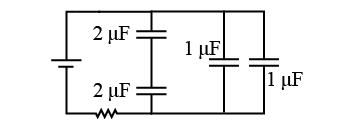 Two charged objects are located near each other. How does their mutual electric force change if their: Two charged objects are located near each other. How does their mutual electric force change if their:
- separation is doubled?
- separation is halved?
- individual charges are each doubled?
 One coulomb of charge passes through a point in an electric circuit every ten seconds. What is the current in the circuit? One coulomb of charge passes through a point in an electric circuit every ten seconds. What is the current in the circuit?
 Two identical charges are located 1 m apart and feel a 1 N repulsive electric force. What is the charge of each particle? Two identical charges are located 1 m apart and feel a 1 N repulsive electric force. What is the charge of each particle?
 A positive and a negative charge are located 25 cm apart and feel an attractive electric force of 5 N. What is the direction and magnitude of the electric force they feel when separated by 50 cm? A positive and a negative charge are located 25 cm apart and feel an attractive electric force of 5 N. What is the direction and magnitude of the electric force they feel when separated by 50 cm?
 Compare the electric force experienced by an electron in the hydrogen atom to the gravitational force experienced by the electron. Compare the electric force experienced by an electron in the hydrogen atom to the gravitational force experienced by the electron.
 What is the electric force experienced by a negatively charged particle Q1 = −10 μC with respect to a positively charged particle Q2 = 20 μC located a distance r = 10 cm away? What is the electric force experienced by a negatively charged particle Q1 = −10 μC with respect to a positively charged particle Q2 = 20 μC located a distance r = 10 cm away?
 Two 10 g objects with charges of +5 μC and −10 μC are separated by 1 cm. Two 10 g objects with charges of +5 μC and −10 μC are separated by 1 cm.
- What is the direction of the electric force?
- What is the magnitude of the force between them?
- What is the acceleration on the positive charge?
- What is the acceleration on the negative charge?
 Two objects with charges +20 μC and −20 μC are located 5 cm apart. Two objects with charges +20 μC and −20 μC are located 5 cm apart.
- What is the strength of the electric force between them?
- What mass would experience an equivalent force due to gravity near the Earth’s surface?
 A particle with a charge of −100μC is located halfway between two other particles: One is located at x = −5 cm and has charge −50μC; the other is located at x = +5 cm and has charge +50μC. What are the direction and magnitude of the force on the middle particle? A particle with a charge of −100μC is located halfway between two other particles: One is located at x = −5 cm and has charge −50μC; the other is located at x = +5 cm and has charge +50μC. What are the direction and magnitude of the force on the middle particle?
| |
 A uniform electric field can be created between two parallel plates that bear equal but opposite electric charges. Suppose that two such plates have a potential difference of 6 V between them. How far apart do they need to be to create an electric field of 50 N/C? (The plates are in a vacuum.) A uniform electric field can be created between two parallel plates that bear equal but opposite electric charges. Suppose that two such plates have a potential difference of 6 V between them. How far apart do they need to be to create an electric field of 50 N/C? (The plates are in a vacuum.)
 An electron has a mass of 9.1×10−31 kg and a charge of −1.6×10−19 C. Suppose you could isolate one electron in a perfect vacuum and then create an electric field to pull upward on the electron. How strong would the field have to be to counteract the electron’s weight? (In other words, how strong would the field have to be to put the electron in a state of force equilibrium?) An electron has a mass of 9.1×10−31 kg and a charge of −1.6×10−19 C. Suppose you could isolate one electron in a perfect vacuum and then create an electric field to pull upward on the electron. How strong would the field have to be to counteract the electron’s weight? (In other words, how strong would the field have to be to put the electron in a state of force equilibrium?)
 Three charged particles, having equal positive charges, are equidistant at the vertices of an equilateral triangle. Sketch their combined electric field. Three charged particles, having equal positive charges, are equidistant at the vertices of an equilateral triangle. Sketch their combined electric field.

 Two 1 μF capacitors are connected in series as shown on the schematic. What is the total capacitance of the circuit? Two 1 μF capacitors are connected in series as shown on the schematic. What is the total capacitance of the circuit?

 Four capacitors are connected in a circuit as shown on the schematic. What is the equivalent capacitance of the circuit? Four capacitors are connected in a circuit as shown on the schematic. What is the equivalent capacitance of the circuit?

 Two 1 μF capacitors can be wired in parallel (left panel) or series (right panel). Suppose that either circuit can be charged with a 12 V battery by closing the switch. How much charge would each circuit store in its capacitor network? Two 1 μF capacitors can be wired in parallel (left panel) or series (right panel). Suppose that either circuit can be charged with a 12 V battery by closing the switch. How much charge would each circuit store in its capacitor network?
|

